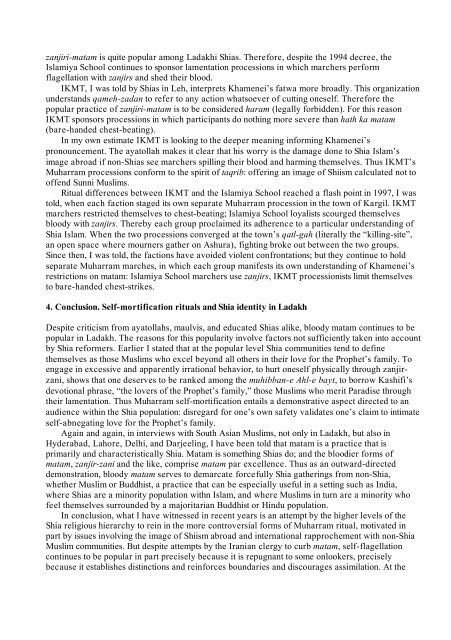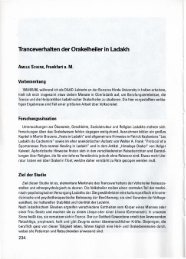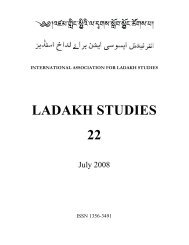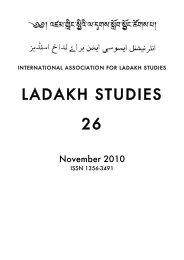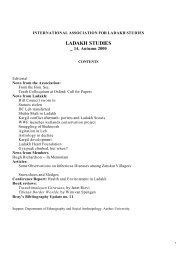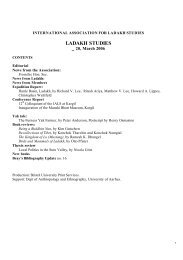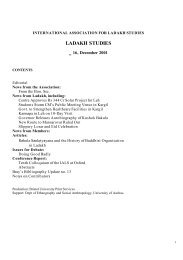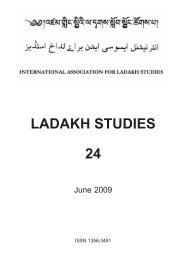LADAKH STUDIES 12, Autumn 1999 - International Association for ...
LADAKH STUDIES 12, Autumn 1999 - International Association for ...
LADAKH STUDIES 12, Autumn 1999 - International Association for ...
You also want an ePaper? Increase the reach of your titles
YUMPU automatically turns print PDFs into web optimized ePapers that Google loves.
zanjiri-matam is quite popular among Ladakhi Shias. There<strong>for</strong>e, despite the 1994 decree, the<br />
Islamiya School continues to sponsor lamentation processions in which marchers per<strong>for</strong>m<br />
flagellation with zanjirs and shed their blood.<br />
IKMT, I was told by Shias in Leh, interprets Khamenei’s fatwa more broadly. This organization<br />
understands qameh-zadan to refer to any action whatsoever of cutting oneself. There<strong>for</strong>e the<br />
popular practice of zanjiri-matam is to be considered haram (legally <strong>for</strong>bidden). For this reason<br />
IKMT sponsors processions in which participants do nothing more severe than hath ka matam<br />
(bare-handed chest-beating).<br />
In my own estimate IKMT is looking to the deeper meaning in<strong>for</strong>ming Khamenei’s<br />
pronouncement. The ayatollah makes it clear that his worry is the damage done to Shia Islam’s<br />
image abroad if non-Shias see marchers spilling their blood and harming themselves. Thus IKMT’s<br />
Muharram processions con<strong>for</strong>m to the spirit of taqrib: offering an image of Shiism calculated not to<br />
offend Sunni Muslims.<br />
Ritual differences between IKMT and the Islamiya School reached a flash point in 1997, I was<br />
told, when each faction staged its own separate Muharram procession in the town of Kargil. IKMT<br />
marchers restricted themselves to chest-beating; Islamiya School loyalists scourged themselves<br />
bloody with zanjirs. Thereby each group proclaimed its adherence to a particular understanding of<br />
Shia Islam. When the two processions converged at the town’s qatl-gah (literally the “killing-site”,<br />
an open space where mourners gather on Ashura), fighting broke out between the two groups.<br />
Since then, I was told, the factions have avoided violent confrontations; but they continue to hold<br />
separate Muharram marches, in which each group manifests its own understanding of Khamenei’s<br />
restrictions on matam: Islamiya School marchers use zanjirs, IKMT processionists limit themselves<br />
to bare-handed chest-strikes.<br />
4. Conclusion. Self-mortification rituals and Shia identity in Ladakh<br />
Despite criticism from ayatollahs, maulvis, and educated Shias alike, bloody matam continues to be<br />
popular in Ladakh. The reasons <strong>for</strong> this popularity involve factors not sufficiently taken into account<br />
by Shia re<strong>for</strong>mers. Earlier I stated that at the popular level Shia communities tend to define<br />
themselves as those Muslims who excel beyond all others in their love <strong>for</strong> the Prophet’s family. To<br />
engage in excessive and apparently irrational behavior, to hurt oneself physically through zanjirzani,<br />
shows that one deserves to be ranked among the muhibban-e Ahl-e bayt, to borrow Kashifi’s<br />
devotional phrase, “the lovers of the Prophet’s family,” those Muslims who merit Paradise through<br />
their lamentation. Thus Muharram self-mortification entails a demonstrative aspect directed to an<br />
audience within the Shia population: disregard <strong>for</strong> one’s own safety validates one’s claim to intimate<br />
self-abnegating love <strong>for</strong> the Prophet’s family.<br />
Again and again, in interviews with South Asian Muslims, not only in Ladakh, but also in<br />
Hyderabad, Lahore, Delhi, and Darjeeling, I have been told that matam is a practice that is<br />
primarily and characteristically Shia. Matam is something Shias do; and the bloodier <strong>for</strong>ms of<br />
matam, zanjir-zani and the like, comprise matam par excellence. Thus as an outward-directed<br />
demonstration, bloody matam serves to demarcate <strong>for</strong>cefully Shia gatherings from non-Shia,<br />
whether Muslim or Buddhist, a practice that can be especially useful in a setting such as India,<br />
where Shias are a minority population withn Islam, and where Muslims in turn are a minority who<br />
feel themselves surrounded by a majoritarian Buddhist or Hindu population.<br />
In conclusion, what I have witnessed in recent years is an attempt by the higher levels of the<br />
Shia religious hierarchy to rein in the more controversial <strong>for</strong>ms of Muharram ritual, motivated in<br />
part by issues involving the image of Shiism abroad and international rapprochement with non-Shia<br />
Muslim communities. But despite attempts by the Iranian clergy to curb matam, self-flagellation<br />
continues to be popular in part precisely because it is repugnant to some onlookers, precisely<br />
because it establishes distinctions and rein<strong>for</strong>ces boundaries and discourages assimilation. At the<br />
28


